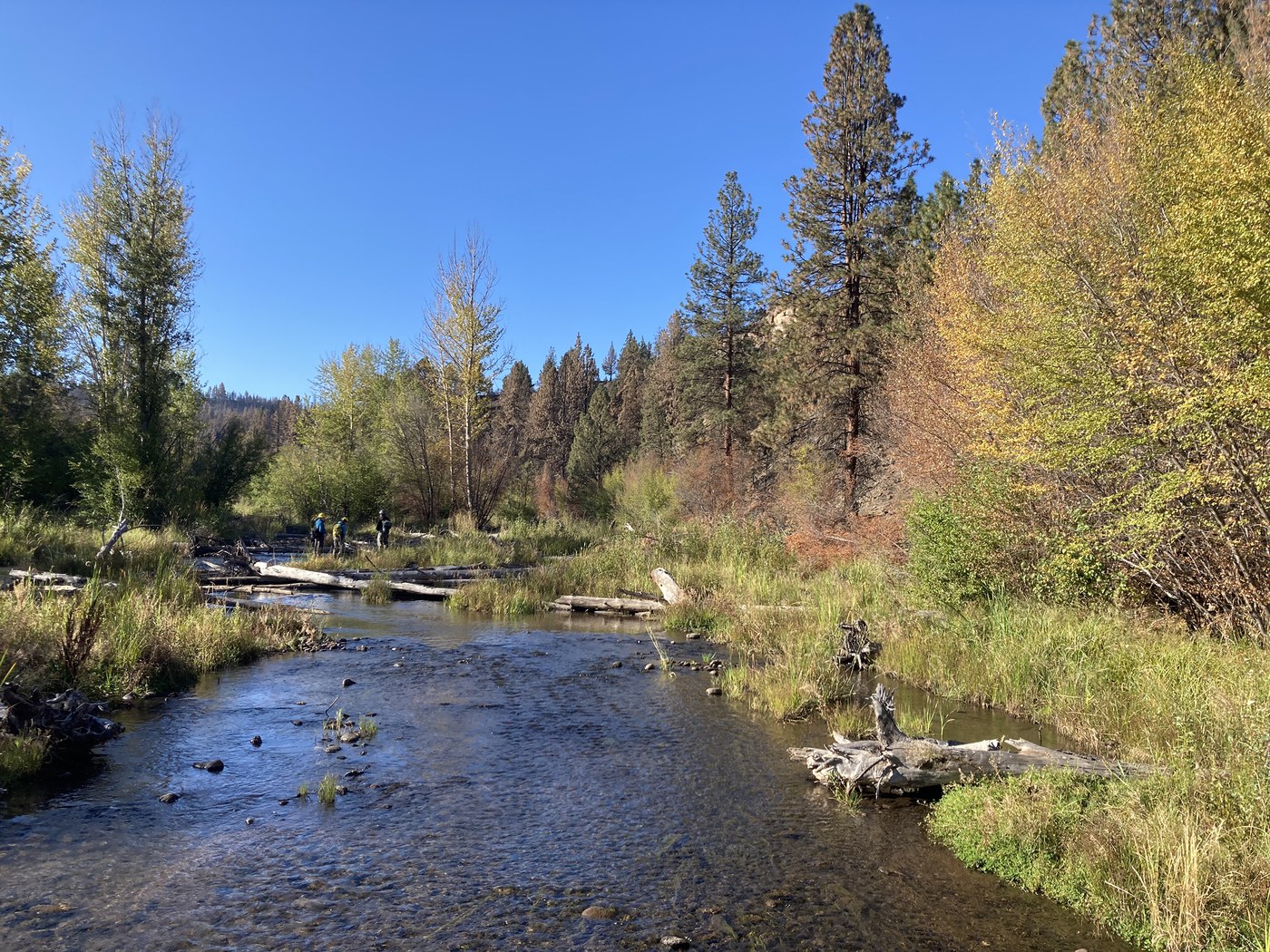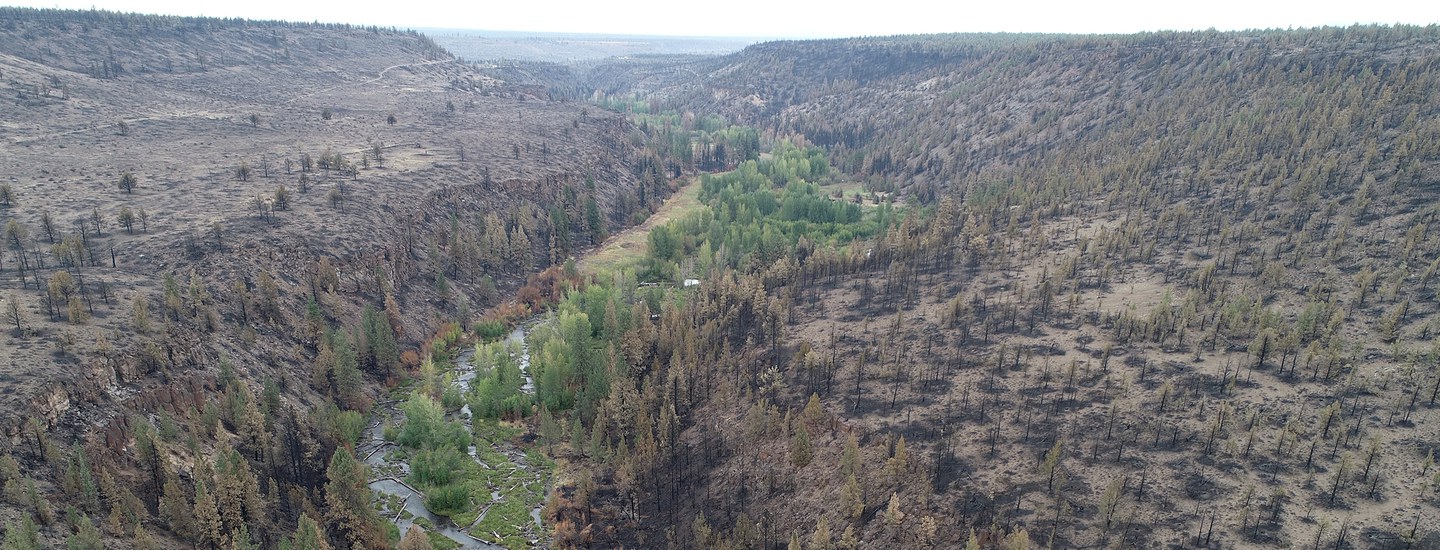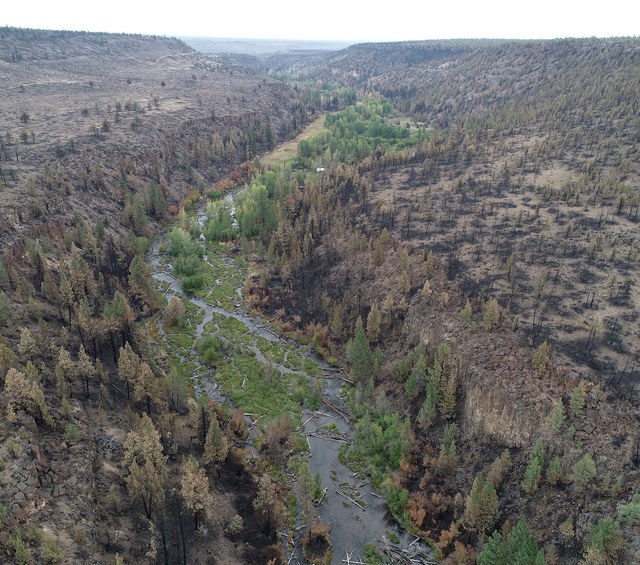When the news broke that the Flat Fire was barreling towards Land Trust properties on Whychus Creek, my heart sank. I thought about the safety of those living at Rimrock Ranch and nearby neighbors. My thoughts then turned to all the time, energy, and resources we’ve put into acquiring, protecting, and restoring these places. As the Land Trust’s restoration specialist, my focus was, of course, on all the amazing habitats that have evolved at our Preserves since the stream restoration projects were completed at Whychus Canyon Preserve (2016) and Rimrock Ranch (2021, 2023). Initial fire information had me fearing the worst, and I began to mentally prepare for drastic changes within our restoration areas.
As a scientist, I’m keenly aware that Central Oregon has evolved with fire, and ultimately this fire would likely benefit some species. But that still didn’t mean that I wasn’t worried about our restoration areas. Once staff were able to get into Rimrock Ranch and Whychus Canyon Preserve, I was thrilled to see that the stream restoration areas were ok! The green valley floor with Whychus Creek winding through it was still there with minimal burned vegetation. In general at Rimrock Ranch, the fire did not penetrate into vegetation in the valley floor where surface water was near the edges of the valley. The same was true in the 2016 restoration area at Whychus Canyon Preserve. However, at Whychus Canyon Preserve, the streamside vegetation in unrestored areas and within restored areas with only one channel of stream flow did burn and carry fire. Thus, surface water connectivity via multiple habitat types (e.g. side channels, wetlands, and large pools) within the floodplain appeared to be the factor that created a fire break. I wasn’t surprised that some of the floodplain that contained surface water remained unburned, but what did surprise me was how quickly fire appeared to stop. For example, some streamside vegetation of mixed height along the edges of the valley burned, so intuitively one would think that fire would carry through the canopy of surrounding vegetation out into the valley floor. Generally, that did not happen.

One of the biggest lessons learned from the Flat Fire was just how resilient connected stream systems are to large-scale disturbances. Resilience in this context does not mean no change within the restoration areas, in fact, dynamic stream channels and wetlands that change with disturbances are key to a self-sustaining stream system. What it means here is the ability for the landscape to absorb disturbances, change as a result, but not unravel. When the projects on Rimrock Ranch and Whychus Canyon Preserve were being planned and implemented, the focus was on constructing a resilient, self-sustaining system. We anticipated that climate change would continue to exacerbate existing issues including, but not limited to, elevated stream temperatures, runoff timing, flooding as a result of more rain-on-snow events, and low base stream flows. We also believed that the project areas would be resilient to wildfire, however that was somewhat unproven with this type of project east of the Cascades. Now our restoration projects on Whychus Creek are a great case study having experienced many disturbances, including the Flat Fire.
There are also other post-fire benefits associated with the stream restoration projects at Rimrock Ranch and Whychus Canyon Preserve. First, we anticipate that some fine sediments from burned areas will enter Whychus Creek from runoff following rain or snowmelt. Fine sediments in the form of sands and silts can have detrimental effects in streams. For example, an overabundance of silts may fill the small spaces within the gravels where summer steelhead or native redband trout create spawning nests. This can reduce egg survival and prevent fish that have hatched from emerging from the nest. Connected floodplains within restoration areas allow for fine sediments to deposit throughout the floodplain surface, in wetlands, and other slow water areas. Further, these sediments provide places for streamside vegetation to grow. Second, it is likely that an abundance of burned material, mainly in the form of wood, will enter Whychus Creek as a result of the fire. Restoration areas are expected to capture much of that material. Captured wood will boost existing logjams and promote other physical processes that create dynamic stream systems. Finally, in streamside areas that burned and lost vegetation, the lack of shade may increase water temperature. Increases in water temperature may affect the mix of macroinvertebrates that inhabit the stream, and can cause behavioral changes to native fish. Pre-fire stream temperature monitoring conducted by the Upper Deschutes Watershed Council showed diverse stream temperatures within project areas. We expect that any increases in steam temperature upstream of project areas will be buffered by existing and future habitat conditions within project areas, This will continue to give fish and other stream inhabitants refuge from elevated stream temperature.
As the weeks pass since the fire, I find myself reflecting on restoration methods used at our Preserves along Whychus Creek and whether or not they are the “right thing.” In the stream restoration field, opinions on that question abound. I often think about the foundation of each project: our goal was to set the stream restoration areas on positive trajectories where stream processes are dynamic and free to evolve with limited management. With that foundation in mind, and the freshly documented resilience of project areas, the answer to the “right thing” question is a resounding yes. Future projects at our Preserves on Whychus Creek and elsewhere, as appropriate, will be implemented with this foundation in mind, as the Flat Fire helped us see the long-term benefits of building strong, resilient natural systems.
Learn more:


